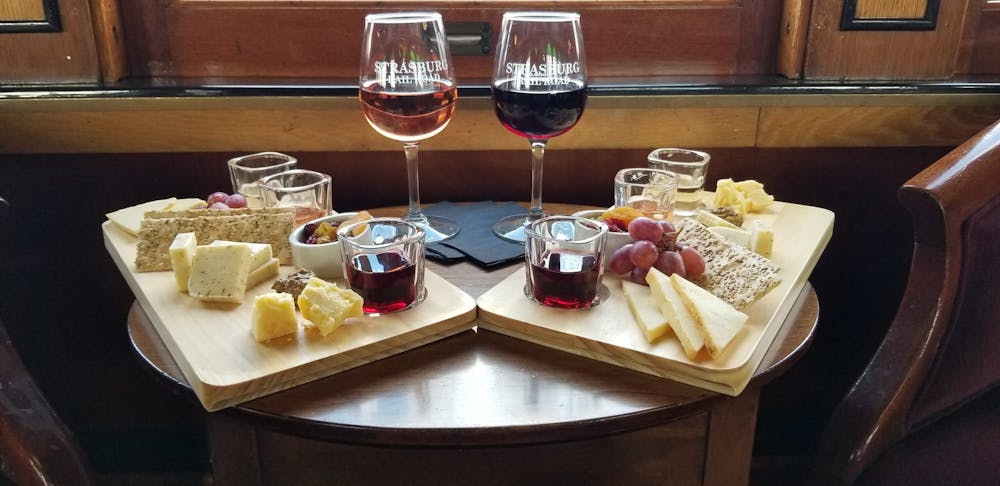THE WINE AND CHEESE TRAIN: YOUR WINE AND TRAIN GUIDE

At Strasburg Rail Road, our popular Wine & Cheese Train is a great way to spend the evening enjoying the company of your friends, that special someone for date night, or just treating yourself to a relaxing steam train ride through Lancaster County.
New to wine and cheese tasting? To help you prepare for your Friday or Saturday evening adventure, we’ve provided some details on the experience as well as a wine guide and how to best pair them. Keep reading to become an expert and fully enjoy your experience with us.
Wine and Cheese Guide
Below, we will include some historical facts, wine terminology, and delicious pairings for you to consider. They are sure to impress your party group for our Wine & Cheese Train events, so pay close attention and learn some interesting facts to share with others.
History of PA Wine
In 1850, Pennsylvania had the third-largest winery production in the U.S. with a winery available in every county.
Once Prohibition hit, Pennsylvania’s wine industry was destroyed. It wasn’t until 1968 when the Pennsylvania Limited Winery Act was passed that the state could begin to make and sell wine again.
In the 70s, only 12 wineries had been established. Now, there are more than 200 wineries within the state alone.
No matter where you are in the state today, you are less than one hour away from at least one winery. Pennsylvania is the nation’s fifth-largest grape-growing state, providing lots of opportunities for wine tastings and tours.
Wine Terminology
When discussing wine, it’s important to know the history of where the wine comes from, as well as the correct terminology. Learning the right lingo can distinguish a novice from an expert, so we’ve rounded up a few of our favorite wine flavors and terms.
Body – a term used to describe the weight and fullness of wine
Dry – opposite of sweet, a wine that has no residual sugar
Tannin – naturally occurring compounds in wine that create a bitter and drying sensation
Complex – a wine with many odors, flavors, and nuances
Varietal – a wine named after the grape that was used to produce it
Regional – a wine named after the region in which it was produced (ex: Champagne, France)
Blend – a wine made from more than one grape variety
Aroma – the smell of wine
Aeration – the intentional addition of oxygen to wine to soften it (Note: not all wines should be aerated)
Finish – lingering textures and flavors of wine
Wine & Cheese Pairings
Now that you’ve got some fun terminology to put to use, it’s time to pair that delicious wine with some cheese. Many experts tend to recommend only white wine with cheese, but the right light-bodied red wine can make a good pairing as well.
Because wine is an astringent and cheese is a fat, they sit on the opposite ends of the taste spectrum and create a unique sensation when paired together.
Here are a few suggestions for your wine and cheese pairings, but keep in mind that everyone’s tastes are different. There’s no right or wrong way to enjoy your wine and cheese.
Recommended Pairings
When drinking a glass of Cabernet Sauvignon, a fairly robust wine, it’s best to pair it with cheeses like Blue cheese, Goat cheese, and Gorgonzola. These cheeses tend to have a melt-in-your-mouth feel to them.
Chardonnay is a top-selling varietal wine with a buttery taste. It pairs best with Parmesan, Gruyere, and Provolone cheeses.
Pinot Grigio is Italy’s most popular white wine with flavors that range from melon to pear. Enjoy this wine with some aged Cheddar, Asiago, and Mozzarella cheeses.
If you prefer a dry red wine, Pinot Noir pairs nicely with Brie, Feta, and Swiss. This lighter-bodied wine is one of the most versatile food wines in the world.
Last but not least, Riesling, a wine that can be enjoyed in both dry and sweet variations is divine when matched with Colby, Gouda, and Monterey Jack.
Strasburg also changes its wine and cheese pairings quarterly. Examples of our pairings include Waltz Apple Crisp with Havarti Dill, Waltz Blush with Smoked Gouda, and Waltz Cabernet Sauvignon with Sharp Cheddar.
The Wine & Cheese Train
Our unique experience begins once the historic steam train departs the station for a 45-minute ride to Paradise, PA, and back.
After the initial introduction, guests are treated to four pairings of regional wines and cheese from Town Clock Cheese Shoppe in Gap, PA to enjoy with the plated crackers.
On the return trip, you can select your favorite wine from the samplings to savor as you soak in the scenery around you. You can also enjoy more complimentary cheese and fruit. Beer is also available for an additional cost.
The Train Cars
Travel in air-conditioned style in our luxurious First Class Parlor Car or the plush comfort of the First Class Lounge Car.
The beautifully appointed Parlor car features elegant burgundy velvet seats, cane-backed chairs, stained glass, a mahogany bar, exquisite woodwork, and delicately painted details.
The First Class Lounge Cars feature similar finery and soft, green velvet upholstered captain’s chairs that swivel for a 360-degree view.
Seating is limited, so be sure to purchase your tickets ahead of time to ensure your spot on the Wine & Cheese Train, as this event often sells out in advance.
Arrival
We suggest arriving at the Strasburg Rail Road half an hour earlier than your scheduled departure. Doing so starts your evening out on a relaxed note and gives you time to check in, pick up your tickets, and enjoy our timeless railroad station and a beautiful evening.
If you have a large group, arriving a few minutes early also ensures you all sit together on the train, as we do not have assigned seating.
While many passengers like to dress up for this event, it is not mandatory. If this is a special date night for you, feel free to wear a dress or nice pants. Girls’ night out? Jeans or capris are a great choice as well! No matter what you wear, we are certain you will have a great time.

 Go behind the scenes on a tour of our renowned mechanical shop and learn all about how we build and refurbish our historic trains!
Go behind the scenes on a tour of our renowned mechanical shop and learn all about how we build and refurbish our historic trains!